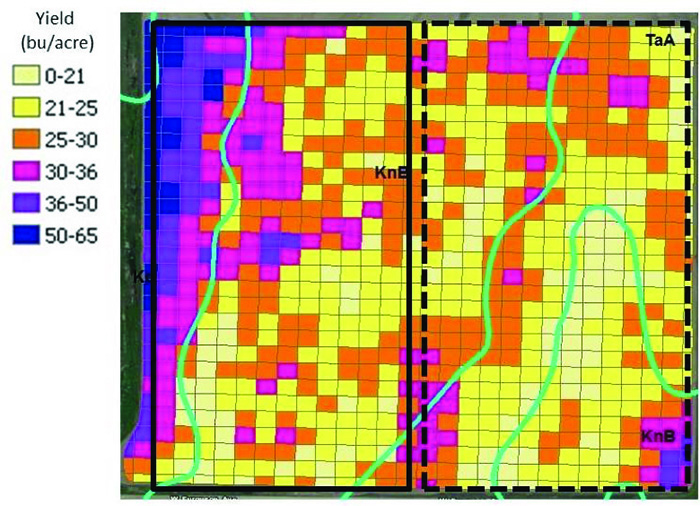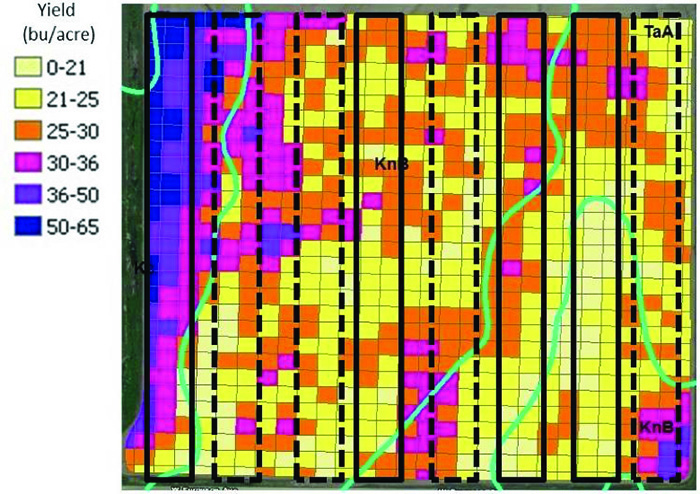Types of On-Farm Demonstrations
Introduction
On-farm demonstrations are a valuable tool in the teaching of new management practices or technologies. Demonstrations allow producers, educators and agency personnel alike to learn how an alternative management option will perform on actual farms at field scale. In addition, unlike research and demonstration projects located on university farms, on-farm demonstrations can be located anywhere a cooperating producer/landowner is willing to host the demonstration. This allows for greater geographic distribution of demonstrations compared to the use of university research farms. It allows demonstrations to be targeted toward a community of producers that are particularly interested in the technology or management alternative, but need validation in a production environment that represents their farm.
Types of On-Farm Demonstrations
There are three general types of demonstrations: proof of concept, strip trials and replicated field trials. Each can be valuable in demonstrating alternative management or technologies, but there are benefits and challenges for each type that should be considered along with the intended goals to be achieved by the demonstration.
Proof of Concept
Proof of concept is the simplest form of on-farm demonstration and can be a useful educational tool. A proof-of-concept demonstration applies an alternative management practice on a field or group of fields, it is discussed during field days to provide an understanding of how it was done and the outcome. This is often combined with a discussion of how the new or alternative practice compared to a neighboring field, where the standard management practice was used. Thus, a proof of concept approach is useful in demonstrating how to implement an alternative practice or how it will perform in a production environment.
Proof-of-concept demonstrations have limitations and are not useful tools for quantifying the impacts of an alternative practice relative to the standard practice. This is because the outcomes experienced on the different fields could be impacted by management unrelated to the alternative practice being demonstrated. For example, planting date, fertilization date, herbicide application date as well as a host of other possible management differences could impact outcomes observed in both the alternative and standard practices. In addition, there could easily be inherent differences in soil type or even rainfall received between the different fields compared. These limitations of the proof-of-concept demonstration are important, if the goal of the demonstration is to quantify the effects of the alternative practice on soil health, soil fertility, crop growth or crop yield. However, they are less important if the goal is to simply provide proof of the concept or to demonstrate how the alternative practice can be implemented locally.
Strip Trials
The second form of on-farm demonstration is the strip trial, in which alternative management practices are imposed in strips within the same field. These provide useful side-by-side comparisons of different practices, hybrids or varieties, which can provide more information and stronger comparisons than comparing one field to another. However, as farmers know, each field has areas that are more fertile than others, and spatial variability within the field must be considered when comparing outcomes from one practice to another.
The simplest form of strip trial is one in which two alternative practices are imposed on two halves of a field and can serve as an example of how spatial variability can influence results. Figure 1 shows a yield map for soybean grown in 2012 in Noble County, OK. Notice the west side of the field contains yields in excess of 50 bu/acre, whereas maximum yields on the east were 36 bu/acre to 50 bu/acre. In fact, the average yield for the west half of this field was 30 bu/acre and the average for the east was 25 bu/acre. This difference was observed without imposing different management strategies on the two sides of the field. In this instance, if two different management practices were imposed (one on the west, and one on the east), which actually had no impact on yield, we would erroneously conclude that the management practice imposed on the west side increased yield.
Figure 1. Soybean field from Noble County, Oklahoma. The average yield on the west side of this field was 30 bu/acre (area outlined in black) and the yield on the East side was 25 bu/acre (area outlined in dotted lines).
Split field comparisons such as this illustrate the problem with using strip trials
to compare the outcome of alternative management practices. However, strip trials
do provide more valid comparisons than proof-of-concept demonstrations because the
impact of variations in rainfall is reduced. Strip trials can also provide a better
comparison than field-to-field comparisons in proof of concept demonstrations because
there is a greater chance that all of the strips received similar management such
as planting date, fertilization and herbicide application.
Crop hybrid or variety demonstrations are often conducted using strip trials. While this type of demonstration decreases the spatial variability between treatments, it still has the same limitations for comparison between treatments. Consider a soybean variety strip trial in Figure 1 with rows planted north to south and each plot width being two passes of a planter. The soybean varieties planted on the west side of the field would have a clear advantage, but unlike the split field comparison, plots would not be wide enough to include lower-yielding areas to offset the high production on the west edge of the field. This flaw can be overcome by replication, which will be discussed in the next section.
The value of strip trials can be increased if there are multiple fields with the same management practices imposed in strips. This decreases the likelihood that spatial variably within the field erroneously impacts the performance of the practices. In fact, this creates a replicated study as will be discussed in the following section where each field is a replicate. Another option is to only assess the impact of the management practices in adjacent strips where they are truly side-by-side. This will minimize the spatial variability of the entire field, but the design still provides only one observation for comparison of a practice.
Replicated Field Trials
Replicated field trials are most commonly used by University Extension Specialists because they allow for statistical analysis to determine the probability that the alternative management practices will result in a different outcome compared to the standard practice. Replicated field trials are very powerful because they allow for the determination of whether or not an alternative practice is really (usually with 95 percent confidence) better than the standard practice through statistical analysis. Like proof-of-concept demonstrations, replicated field trials can be used to demonstrate a practice is viable at a particular location. However, replicated field trials also allow us to determine the likelihood that a new practice will result in a better outcome compared to the standard practice.
Replicated field trials require each management alternative be imposed in multiple locations within a field. Figure 2 shows the layout for a replicated demonstration, comparing two practices, imposed on the previously mentioned soybean field. Notice that each management practice is replicated four times and placed in random positions in the field. This reduces the impact of the spatial difference in soil type on the measured outcomes. For example, the average yield for the areas outlined in black in Figure 2 is 29 bu/acre and in areas outlined in dotted lines, the average yield is 27 bu/acre. By using multiple replications randomly placed in the field, the influence of yield variability unrelated to the management practices imposed is decreased as compared to the split-field example provide in Figure 1. Remember, the yield differences are the result of variability in the field, without the application of different treatments. The introduction of GPS-guided equipment has made this type of design much easier to implement, as the drill or sprayer can easily be set to apply a skip (untreated control) every other pass.
Figure 2. Map of Soybean yields collected in Noble County. Replicated strips are randomly located within this figure. The average yield for strips outlined in black is 29 bu/acre and for those outlined in dotted lines the average yield is 27 bu/acre.
Replicated field trials are very powerful tools, especially when one of the goals
of the demonstration is to compare the alternative practice to a standard practice.
If this type of design is used, statistical analysis can be used to determine if the
differences among treatments, hybrids or varieties are likely to occur on a consistent
basis or, conversely, if they simply occurred due to luck of the draw. The details
of performing this type of statistical analysis is beyond the scope of this fact sheet,
but will be covered in another factsheet provide as part of this series about on-farm
demonstrations. Replication is also critical if the information is intended to affect
policy.
Summary
On-farm demonstrations are probably the most powerful tool available to educate landowners, producers and other agricultural professionals about new management practices and technologies. When determining which of the three types of demonstration to choose, it is important to have a clearly defined goal. If your goal is to simply show people how to implement a practice or technology in a specific location, then the proof-of-concept demonstration is appropriate. However, if your goal is to demonstrate that a new practice is likely to result in a better outcome than a standard practice, strip demonstrations or replicated field trials are required. Replicated field trials are preferred unless strip demonstrations are implemented in multiple fields to reduce the erroneous interpretation of outcomes that can be caused by inherent variability within a field.
Jason Warren
Soil and Water Conservation Extension Specialist
Randy Taylor
Extension Machinery Specialist
Jeff Edwards
Small Grains Extension Specialist


